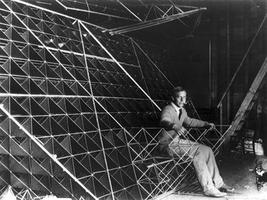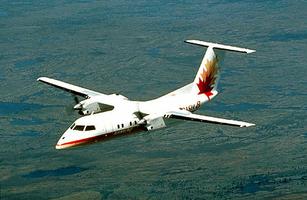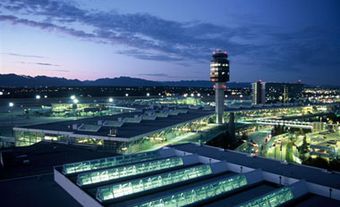Aviation
Aviation, the art and science of flying, has been a practical reality since the early 20th century. Canadians have participated in its development almost from its inception. Significant early research was initiated by Wallace Rupert Turnbull, who built the first wind tunnel in Canada in 1902, and by the far-sighted Alexander Graham Bell, who founded the Aerial Experiment Association in 1907 and recruited John McCurdy and F.W. Baldwin (co-founders with Alexander Graham Bell of the Aerial Experiment Association), as well as 2 Americans, Glenn Curtiss and Tom Selfridge.
Working from laboratories in Hammondsport, NY, near Curtiss's engine factory, and Baddeck, NS, just west of Sydney, the team developed several aircraft. The Red Wing, designed by Selfridge and completed in 1908, made 2 successful flights at Hammondsport, piloted by Baldwin, before crashing. Baldwin thus became the first Canadian to fly, albeit in the US. The White Wing, also piloted by Baldwin, took to the air next. Curtiss's June Bug was third, and was the first to remain airborne for a full 1000 m. Finally, after an initial attempt at Hammondsport, McCurdy's Silver Dart was shipped to Baddeck, and on 23 February 1909 he made the first powered, heavier-than-air flight in Canada.
In August 1909, in an attempt to find additional financing, McCurdy flew both the Silver Dart and the Baddeck I (the first aircraft made in Canada) before an assembly of militia officers at Camp Petawawa, Ont. Though both aircraft performed well in the air, neither survived its encounter with the rough landing field. Despite this setback, interest in aviation survived, and more experimental craft were built.
In 1910, William Wallace Gibson, of Victoria, designed and built the first successful Canadian aircraft engine. Also in that year, 3500 people filled the stands at Minoru Park race track in Richmond, BC, to watch American Charles K. Hamilton's rickety biplane sputter its way to becoming the province's first flight. The following day, he flew his airplane to New Westminster and back, a distance of 20 miles.
In 1911 McCurdy flew from Key West to Havana, the longest overwater flight to that date. John Porte's planned flight from Newfoundland to Ireland in 1914 was cancelled by the onset of war.
The first woman to pilot a plane in Canada was American Alys McKey Bryant, who had been trained by Glenn Curtiss. She took to the air on 31 July 1913, at Minoru Park. A week later in Victoria, her husband, John Bryant, became the first aviator to fly over the downtown area of a British Columbian city. Later that day, he was instantly killed when one of the wings of his airplane collapsed. He crashed onto the roof of a building, becoming Canada's first aviation fatality.
Commercial Aviation
History was again made on 3 March 1919 when Seattle-based aircraft manufacturer William Boeing and pilot Eddie Hubbard carried 60 letters from Vancouver's Coal Harbour to Seattle, marking the first international airmail delivery.
The first commercial cargo flight in Canada took place in October 1913, when Montréal newspapers were carried from Montréal to Ottawa. Unfortunately the aircraft crashed on the return takeoff. In 1919 the Canadian Pacific Railway requested parliamentary approval to amend its charter to include air transportation. The government extended regulation to cover the fledgling industry by passing the Aeronautics Act (1919), which created the Air Board to consider such requests.
The first commercial passenger flight took place in 1920, when 2 bush pilots flew a fur buyer north to The Pas, Man, from Winnipeg. One month later, the first regular services were initiated when Imperial Oil chartered several Junkers aircraft to ferry men and supplies from Edmonton to the newly discovered oil fields at Fort Norman (now Tulita), NWT.
From 1920 to 1937 air transport expanded rapidly, although it still comprised a large number of small carriers, operating predominantly north-south routes, feeding traffic from the railroads to the interior (see Bush Flying). In 1927 the Post Office authorized air delivery in cases where winter interrupted surface transportation.
Bush pilot Grant McConachie formed United Air Transport in 1933, with one Fokker Universal aircraft. In 1938 the company became Yukon Southern Air Transport, connecting Vancouver, Edmonton and the Yukon. McConachie later became president of Canadian Pacific Air Lines.
When United Airlines' first flight from Seattle to Vancouver arrived on 1 July 1934, more people were on hand to greet the aircraft than were on board. (The Boeing 247D could carry only 10 passengers.)
In 1936 Parliament transferred control of civil aviation from the Department of National Defence(DND) to the newly created Department of Transport, then under the aegis of C.D. Howe. Faced with applications from US investors who wished to open a transcontinental passenger air route, and pressure from several Commonwealth countries that wanted the same system established as part of a more grandiose all-British, round-the-world network, Howe approached the 2 major railways and Canadian Airways, requesting that they participate in a nonprofit, government-guaranteed national carrier.
CPR and Canadian Airways backed away over the issue of government representation on the board of directors, and Howe's preference shifted to the establishment of an all-government carrier. Thus, Trans-Canada Air Lines was formed in 1937 as a wholly owned subsidiary of the Canadian National Railways (CNR). The carrier commenced passenger service on 1 April 1939. In 1964 the name was changed to Air Canada, and in 1977 the Air Canada Act transferred share ownership from CN to the Crown. Air Canada, now Canada's largest airline, was fully privatized by 1989.
CPR acquired 11 aircraft operating companies during 1941 and continued operations under the name United Air Services Ltd. The name was changed on 24 March 1942 to Canadian Pacific
Flights were inaugurated to Australia, Japan and Hong Kong (1949); to South America (1953); and to Europe (1955), pioneering the transpolar Vancouver-Amsterdam route. In order to expand quickly enough to compete effectively with Air Canada under a deregulated environment, CP Air purchased Eastern Provincial Airways in 1984 and Nordair in 1985. CP Air was in turn taken over by Pacific Western Airlines in 1987, and the merged carrier was renamed Canadian Airlines International Ltd (CAI). It later expanded with the purchase of Wardair, a major charter airline that had grown from a bush pilot operation founded by aviation pioneer Max Ward.
Reform
With the advent of Economic Regulatory Reform (ERR) in Canada in 1984, most of the country underwent a deregulation program similar to that in the United States, including serious financial losses to both major airlines during the recession of 1991-93, during which Air Canada and CAI's net losses totalled over one billion dollars each. The major effects of ERR during the 15-year period ending in 1999 were:
• The emergence of 2 large trunk carriers (Air Canada and CAI) competing directly on most major domestic routes.
• The disappearance of a regional airline industry in Canada (Transair, EPA, Nordair, PWA) and the emergence of 2 commuter/feeder airline "families" owned by or otherwise affiliated with one or the other of the 2 major carriers.
• The incorporation of each of the Canadian airline families into a mega-carrier structure through a variety of acquisitions and marketing-related agreements, with Air Canada joining the United/Lufthansa-led Star Alliance and CAI becoming part of the American/British Airways-led one-world structure. These mega-carrier alliances (which include smaller airlines in other regions, as well) began to compete with each other on a global basis, as well as with other international conglomerations such as KLM/Northwest/Continental and Skyteam (Delta/Air France/Alitalia/others).
• The rationalization of Canada-US services by the signing of an "Open Skies" agreement in 1995, giving air carriers on both sides of the border direct access to new trans-border markets.
• The complete erosion of the equity base of Canada's 2 major airlines at the height of the aircraft re-equipment cycle, requiring them to absorb massive amounts of new debt and lease obligations at the worst possible time.
• The development of specialized carriers, such as WestJet, whose strategy has been to develop low-cost niche markets where they do not compete directly with the major incumbents' trunk routes. Some of these airlines, such as Canada 3000, began an expanded program of scheduled services previously operated as charters.
Early in 1999 it became apparent that CAI would require a significant equity infusion to continue to operate as a major nationwide airline. In June, Air Canada proposed that it purchase CAI's international routes and operate them as a joint AC/CP code-share. Under this proposal, CAI routes and services would have been limited to the North American continent. In August the government announced a 90-day suspension of the competition rules to allow the airlines and other interested parties to discuss airline restructuring proposals, emphasizing the long-term stability of the industry. Two competing proposals were tabled, one supported by Onex, AMR and CAI, and one led by Air Canada, United Airlines, Lufthansa and the CIBC, with the Air Canada proposal eventually being approved by the shareholders. On 4 January 2000, Air Canada formally took control of CAI and began the process of integration.
Subsequently, several new (and some old) airlines aggressively expanded their scheduled services to fill the perceived market void, with mixed results. Canada 3000 bought out several smaller independent carriers and quickly became Canada's second-largest airline. However, the shock waves from the September 11, 2001 terrorist attacks, in conjunction with a business recession based on the collapse of the technology sector, changed the paradigm yet again. Air traffic dropped sharply (and revenues dropped even more sharply, as companies drastically reduced travel at full fares), and this "double whammy" was enough to see the disappearance of most of the low-cost competition (Canada 3000 filed for bankruptcy in November 2001). Once again, Air Canada's market share grew, with new competition emerging slowly.
Canada's Airline Industry Today
• Air Canada, which has embarked on a strategy of offering several different brands, including:
- Air Canada itself, the traditional international airline.
- Air Canada Jazz, the consolidation of its regional subsidiaries.
- Air Canada Jetz, a charter service for corporate clients, professional sports teams, and others.
• WestJet, the largest and most successful of the low-cost airlines.
• Porter Airlines, a regional passenger carrier based at Toronto City Centre Airport, launched February 2006.
• An agglomeration of small regional carriers, many of which are struggling to find their own profitable niche market. As a contract carrier, Air Canada Jazz operates regional flights on behalf of Air Canada.
• CanJet, a full-service charter airline. In May 2009, CanJet and Transat (a tour operator that operates its own airline, Air Transat) entered a 5-year partnership to provide service from 20 Canadian cities to approximately 20 sunny, holiday destinations. A similar agreement between Transat and WestJet expires 31 October 2010).
• Charter carriers led by Air Transat and Skyservice, which successfully survived the industry shake-out, as well as a number of new start-ups.
Government and Aviation
In a Supreme Court decision in 1932, aviation was considered wholly within federal jurisdiction with minimum provincial regulation. Responsibility for air safety was exercised by Transport Canada. Eventually, it became apparent that the government was not the ideal body to manage all facets of air transportation. Of the 726 certified airports in Canada, Transport Canada owned, operated or subsidized 150; 94% of all air passengers and cargo are handled at only 26 airports. There was no statutory, regulatory or policy framework defining the federal government's role in the operation of Canadian airports. The federal government had to assume increased responsibility with no consistency or focus on a clearly defined system or role. It also had to play a wide variety of roles related to airport operations. Federal policies, applied nationally, are sometimes inconsistent with the needs of communities served by local airports, leading to national and regional imbalances in facilities and funding. The 26 major airports could cover their operating costs with earned revenues, while considerable federal resources were spent supporting a large network of airports serving only 6% of air passengers. Expenditures on under-used facilities burdened both taxpayers and users.
To develop a safe, commercially oriented and cost-effective system of airports, the federal government established the National Airports Policy (NAP) in July 1994. Under the NAP, the federal government maintains its function as regulator but changes its role from airport owner and operator to owner and landlord. The federal government retains ownership of the 26 major airports, known as the National Airports System (NAS), which are leased to Canadian airport authorities (CAAs) under the NAP. Local operators are responsible for financial and operational management. Ownership of regional/local and other smaller airports has been transferred to regional interests. Remote airports providing exclusive, reliable, year-round access to isolated communities and that were in receipt of federal assistance continue to be supported. As of 1 November 2002, 122 of the 136 airports slated for divestiture had been transferred to local or regional authorities.
The government handed over responsibility for air navigation services to Nav Canada, which was established in November 1996. It is a non-profit organization that collects fees for its services, which used to be paid for under the now-abolished Air Transportation Tax but are now collected as a specific charge on issued air tickets. The federal government continues to be responsible for all aspects of aviation safety, including policy setting, airport transfer agreements, airport certification and regulation.
Economic regulation is carried out by the Air Transport Committee, part of the Canadian Transport Agency. The agency is an independent, federal agency responsible for dispute resolution and economic regulation within all areas of the Canadian transportation industry. Along with its roles as an economic regulator and an aeronautical authority, the agency works to facilitate accessible transportation and serves as a dispute resolution authority over certain transportation rate and service complaints. Among other functions, the CTA has appointed an Air Travel Complaints Commissioner, whose mandate is to attempt to resolve complaints by consumers about air carriers either directly or in co-operation with other parts of the agency and other government bodies when the traveller is not satisfied with how an airline has dealt with his or her complaint.
The Future
When Mirabel Airport (which no longer handles passenger traffic) was being planned during the late 1960s, air traffic in Canada had been growing at the rate of about 15% per year and was expected to increase indefinitely. Provision was made in the design to handle such expected improvements as the supersonic transport (SST) and the 800-passenger stretched double-deck jumbo jet. By the turn of the century long-term projections of traffic growth had fallen to about 3% per year, the super jumbo was still on the drawing boards, and the SST was losing money. Aircraft designs and airline operations are being developed to suit reduced traffic expectations, and the emphasis is on fuel economy and operational efficiency through improved aerodynamics, engine design, structural weight and operational control procedures. Cost will be the primary consideration in the future.

 Share on Facebook
Share on Facebook Share on X
Share on X Share by Email
Share by Email Share on Google Classroom
Share on Google Classroom






